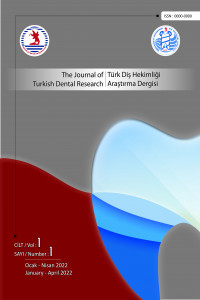Yer tutucu Olarak Kullanılan Lingual Ark Apareyinin Klinik Başarısının Değerlendirilmesi
Çocuk, Lingual Ark Apareyi, Yertutucu
Evaluation of Clinical Success of Lingual Arch Applience used as Space Maintainer
Child;, Lingual Arch Appliance, Space Maintainer,
___
- Kaynaklar
- Brothwell DJ. Guidelines on the use of space maintainers following premature loss of primary teeth. J Can Dent Assoc. 1997;63:753- 66.
- Ngan P, Alkire RC, Fields H Jr. Management of space problems in the primary and mixed dentitions. J Am Dent Assoc. 1999;130:1330-9. doi: 10.14219/jada.archive.1999.0403.
- Ghafari J. Early treatment of dental arch problems. I. Space maintenance, space gaining. Quintessence Int. 1986;17:423-32.
- Tulunoglu O, Ulusu T, Genç Y. An evaluation of survival of space maintainers: a six-year follow-up study. J Contemp Dent Pract. 2005;15;6:74-84.
- Richardson ME. The relationship between the relative amount of space present in the deciduous dental arch and the rate and degree of space closure subsequent to the extraction of a deciduous molar. Dent Pract Dent Rec. 1965;16:111-8.
- Ghafari J. Early treatment of dental arch problems. I. Space maintenance, space gaining. Quintessence Int. 1986;17:423-32.
- Kamki H, Kalaskar R, Balasubramanian S, Badhe H, Kalaskar A. Clinical effectiveness of fiber-reinforced composite space maintainer and band and loop space maintainer in a pediatric patient: A systematic review and meta-analysis. Int J Clin Pediatr Dent. 2021;14(Suppl 1):S82-S93. doi: 10.5005/jpjournals- 10005-2044.
- Mosharrafian S, Baghalian A, Hamrah MH, Kargar M. Clinical evaluation for space maintainer after unilateral loss of primary first molar in the early mixed dentition stage. Int J Dent. 2021;7:3967164. doi:10.1155/2021/3967164.
- Gianelly AA. Leeway space and the resolution of crowding in the mixed dentition. Semin Orthod. 1995;1:188-94. doi: 10.1016/ s1073-8746(95)80022-0.
- Qudeimat MA, Fayle SA. The longevity of space maintainers: a retrospective study. Pediatr Dent. 1998;20:267-72.
- Qudeimat MA, Fayle SA. The use of space maintainers at a UK Paediatric Dentistry department. ASDC J Dent Child. 1999;66:383- 6.
- Rajab LD. Clinical performance and survival of space maintainers: Evaluation over a period of 5 Years. J Dent Child. 2002;69:156–60.
- Rebellato J, Lindauer SJ, Rubenstein LK, Isaacson RJ, Davidovitch M, Vroom K. Lower arch perimeter preservation using the lingual arch. Am J Orthod Dentofacial Orthop. 1997;112:449-56. doi: 10.1016/s0889- 5406(97)70054-4.
- Owais AI, Rousan ME, Badran SA, Abu Alhaija ES. Effectiveness of a lower lingual arch as a space holding device. Eur J Orthod. 2011;33:37-42. doi: 10.1093/ejo/cjq022.
- Law CS. Management of premature primary tooth loss in the child patient. J Calif Dent Assoc 2013;41:612-8.
- Fathian M, Kennedy DB, Nouri MR. Laboratory-made space maintainers: a 7-year retrospective study from private pediatric dental practice. Pediatr Dent. 2007;29:500-6.
- Moore TR, Kennedy DB. Bilateral space maintainers: a 7-year retrospective study from private practice. Pediatr Dent. 2006;28:499-505
- Başlangıç: 2022
- Yayıncı: Ondokuz Mayıs Üniversitesi
Yer tutucu Olarak Kullanılan Lingual Ark Apareyinin Klinik Başarısının Değerlendirilmesi
Siloran-esaslı Kompozitlerde Ön Isıtma/Preheating of Silorane-Based Composites
Nihan GONULOL, Emel KARAMAN, Duygu TUNCER
Beyaz Nokta Lezyonlarının Tedavisinde Kullanılan Farklı Yöntemlerin Yüzey Renklenmesine Etkisi
Betül Kübra KURUCU, Lena ALMASIFAR, Emel KARAMAN, Nihan GONULOL
Doğal Ürünlerin Periodontolojide Kullanımı
Atanur SARIOĞLU, Mehmet Faruk KOCA, Tuğrul KIRTILOĞLU
Mandibular Lezyonun Fark Edilmesiyle İlk Tanısı Konan Polyostotik Eozinofilik Granüloma
